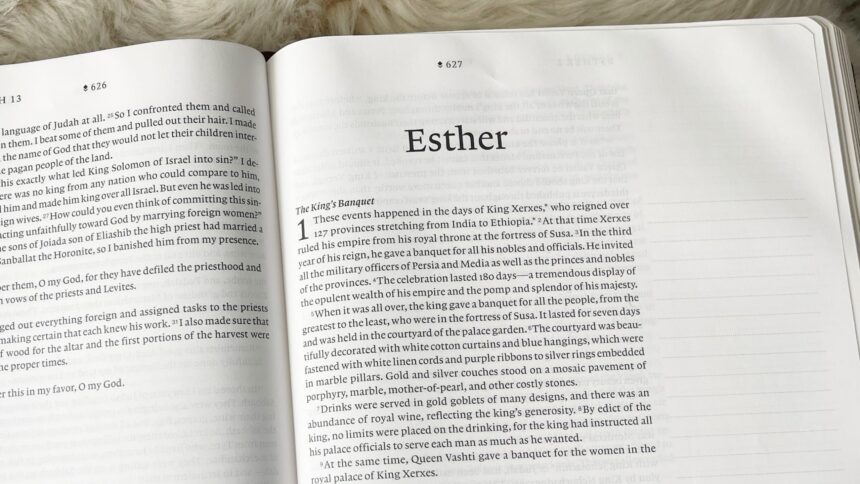I was asked me to pick my “favourite Bible character or characters and tell ‘why’”
Who would you pick? Jesus is the top contender of course; Paul would be a close second; John would rank right beside Paul, and Peter would for sure be in the top 10. They’re, of course, all in the New Testament. I chose someone other than these and soon you’ll find out who and why. It’s kind of like CTV’S W5. The Old Testament is much larger with even more notables, such as Abraham, Isaac, Jacob, Noah, Moses, David, and there all the major and minor prophets. I chose two others, one a woman and one a man. So, ladies first!
Her name is Esther.
The book of Esther is not very big. It’s only 10 chapters long, and the last chapter is only made up of 3 verses. But if you like drama, intrigue, suspense, retribution and justice, “old testament style”, then this story and Esther’s life is for you!
The time of this narrative is around the years of 483-473 BC. The 70 years of Babylonian captivity had ended about 538 BC. Nebuchadnezzar, the king of Babylon (part of present day Iraq) had taken most of the Jewish population captive and they would be held in exile for 70 years. But then the Persian king, Cyrus, conquered Babylon and he gave the Jews permission to return to their land. Details of the rebuilding of the temple and the walls of Jerusalem are provided in the two books preceding “Esther”. “Ezra” and “Nehemiah” are those two books. This was a time of violence in the history of the Jewish people.
But, back to Esther. A dastardly plot to exterminate the Jews is hatched by a guy name Haman. He is both evil and arrogant, and he’s the mastermind behind the plot to exterminate the Jewish nation. The king at this time was Xerxes, and he ruled 127 provinces from India to Ethiopia. In the third year of his reign, he threw a lavish party for ministers and officials under him and it could be rightly called “the mother of all parties.” His beautiful wife Vashti was holding an event for the women inside the Palace. Xerxes called for her to come to him but she refused and he immediately went into a rage and summoned his counsellors to secure their advice. They advised the king that other women would likely follow Vashti’s example and refuse to obey their husbands’ demands, so the king should have her permanently banned from his presence. She must be replaced! Enter Esther!
The king orders that a search be made for beautiful virgins throughout the empire and many are found including Esther. Interestingly, Esther had kept her nationality secret as advised by her cousin Mordecai who had adopted her as her parents had both died. Eventually, Esther is brought to the king and he fell in love with her and made her Queen in place of Vashti. Mordecai was very protective of Esther and every day he’d stroll by the palace gates to listen to the “talk” in order to make sure she was doing well. One day he heard there was a plan afoot to kill King Xerxes.
Another person in her story is named Haman. He was promoted by the king to a very High position and he hated the Jews. Everyone had to bow before him, everyone that is, except Mordecai. The arrogant Haman was enraged, told the king, and influenced Xerxes to sign a decree to have all the Jews exterminated. When Mordecai heard this, he was naturally devastated. Soon queen Esther got the news and was challenged by Mordecai that she should go before the king and persuade him to change his mind. Perhaps the best known verses of the book of Esther are verses 12-14 of chapter 4 where Mordecai tells her, “maybe you were made Queen for just such a time as this.” When she asked to come into the king’s presence she did so courageously, having first prayed and fasted. She was welcomed by the king who asked her what it was that she was requesting. She invited him to come with Haman the next day to a feast she was preparing for him. Of course, Haman’s pride swelled as he was going to be invited to the same party as the king! At the same time, Haman ordered that gallows be built on which to hang Mordecai. But that night, the king had a restless sleep. He ordered that the day by day record of events be brought to him and therein he read about the plot against his life as reported earlier by Mordecai. The king wanted to honour Mordecai for saving his life.
In an ironic plot twist, Xerxes orders Haman to put a royal robe on Mordecai and place him on one of the king’s horses and have him paraded throughout the city to thank and honour this loyal subject Mordecai. Of course, Haman was humiliated and infuriated. Eventually, the next day Esther prepared another banquet for the King and Haman.
This time she pleads for her life and the lives of the Jewish people. The king is enraged and demands to know who the evil person is who has fooled him. Esther says, “it’s Haman!” Ironically, Haman is hung on the gallows he’d built on which to hang Mordecai. So now you know why I just loved the courage and decisive leadership that Esther portrayed.
Indeed, she had “come to the kingdom for such a time as this.”
God’s plan was to save and preserve His people out of whom the Messiah would come.
Next, I’ve always loved the story of Nehemiah.
His book of history comes right before that of Esther. The walls of Jerusalem had been broken down and neglected during the 70 years most of the Jewish people had been exiled to Babylon. The King of Persia (Iran) agreed to Nehemiah’s request to return to Jerusalem for the express purpose to complete the project.
What I love about this man are the steps he employed in the process. He went from being a “bureaucrat” in the employ of Persia to a building contractor in Jerusalem. His reliance on God’s direction and provision; his administrative acumen; his strategic planning are just marvellous to read about. For example, he asked for the king to provide him with letters that would authenticate his project back in Jerusalem. He surveyed the situation in the middle of the night having kept his reason for being back in Jerusalem a secret. Then he gave his report to the local officials.
Each of the gates of the city were rebuilt by families or groups. They did it section by section. When he faced open opposition and ridicule he prayed, and kept at it! He had to confront doubt and harassment so he armed the builders and each one kept a sword in one hand and the tool needed in the rebuilding of the walls in the other. By night they all were guards and by day they were builders. A trumpet sound was the signal of trouble, so if they heard that they were to come to the troubled area. He developed an “esprit de corps” among the workers especially the guards. He led by example donating financially himself to the cause. Anything he asked of his people he stepped up and did the same. In the face of extreme intimidation, he held his ground and responded like a spirit-filled leader would/should today. He prayed, “God, give me the strength.”
In everything, as the project proceeded step by step, he gave the glory to God who had provided the necessities, the workmen, the guards – everything. He took no glory for himself; he sacrificed incredibly as good leaders do, and amazingly the job was completed in only 52 days. If you’ve ever been to Jerusalem and seen the size of the stones you must stand back and marvel at this feat of accomplishment.
Now turning to the New Testament, consider James with me.
He was an early church Pastor and from the tenor of the letter, he was addressing a sick church. It is to be expected that churches, even today, are not places of perfection! They are really like hospitals where people who are in need and who are sick go for healing, encouragement and compassionate love. At least, that’s the way it’s supposed to be. Growing churches today exhibit that kind of care. But I digress… James, it is believed, was a half-brother to Jesus. He is remembered, among many reasons, for his strong prayer life, and indeed, tradition says that he had the nickname “old camel knees” because of the thick calluses built up on his knees from years and years of prayer. Commentator Matthew Henry informs us that James “was an eminent example of those graces which he presses upon others.” Henry goes on to tell us that James was “revered for his justice, temperance and devotion.” My deep appreciation for James and his epistle is the easy, wise counsel that he offers to a church that is experiencing signs of degeneracy in matters of faith and manners. Libertine doctrines were prevalent in James’ day, even as they crowd upon the church today. A portion of James’ writing has provided much debate over the years. It’s found in Chapter 2:14-26. It’s the push and pull between faith and works. A cursory reading can lead the reader to think that James is exalting “works and deeds” over faith. But a more reasoned understanding is not that at all. Rather, he’s saying that following the act of faith, if it’s real faith, it will be accompanied by works. The order is important;
It’s faith followed by works not the other way around.
James deals with favouritism in the church; taming the tongue among Christians; he talks about wisdom; he deals with the matter of Christians submitting to God; he admonishes the boasters; James warns the rich who are oppressing the poor; the matter of suffering he tackles and reminds the reader that we must be patient in suffering just like the farmer who plants the seed and then must wait for the eventual harvest. He concludes his letter admonishing his readers to pray if they’re in trouble. He concludes that section with, “the prayer of a righteous person is powerful and effective”, then he gives the example of Elijah. This book is a “must read regularly” for it is intensely practical and easy to understand. That said, it’s not always that easy to put into action James’ admonitions.
So, there you have them – my three – Esther, Nehemiah and James.

Stewart Hunter (Monthly Contributor)
Stewart lives with his wife Gudrun in Stittsville, ON. For over 55 years Stewart has served as a pastor as well as in varied positions in The PAOC. Stewart and Gudrun are members of Bethel Pentecostal Church, Ottawa.

